-
1. c4 e5
English Opening
2. g3 d6
3. Bg2 g6
4. d4 Nd7
5. Nc3 Bg7
6. Nf3 Ngf6
We have now reached a Kings Indian Defense by transposition of moves!
This was an unusual choice for Yusupov who normally doesnt play the KID.
The fianchetto variation is characterized by the white bishop at g2. It is a solid line where black finds it difficult to obtain counterplay in the usual KID methods. Whites fianchettoed bishop adds extra protection to his kingside and white has no intention of blocking the center so black cannot play for a standard KID attack. This line by white is favored by players from the former Soviet Union.
7. 0-0, 0-0
8. Qc2?!
This is a dubious deviation from the well-trodden path of 8.e4 which is best.
8...Re8
Development, but stronger was 8...exd4 9.Nxd4 Nb6!. The text allows White an even more favorable transposition into the normal 8.e4 lines.
9. Rd1 c6
10. b3 Qe7
Not a happy placement of the Queen.
11. Ba3!?

Interesting but not the best, but better than the passive 11. e3, Nf8 recommended in some opening manuals at the time.
The strongest continuation is 11.e4! exd4 12.Nxd4 Nc5 13.f3 a5 14.a3 White keeps a persistent advantage. The text anticipates ...e5-e4, because it prevents the follow-up ...d6-d5.
11...e4!
Black has an intiative.
12. Ng5 e3
13. f4?!
This natural-looking move is actually a positional inaccuracy. It makes White's kingside structure quite brittle. Black can now concentrate on such conceptions as ...h7-h5-h4xg3 and ...Nf6-h5. Therefore, correct was 13.f3! However even here black has fine play. Yusopov gives 13...Nf8 14. Nge4 (or 14. Nce4, Bf5 15. Qc3, Bxe4 16. Nxe4 [Perhaps a better try is 16. fxe4!? as in the game Schultz-Jackelen, Porz 1990. which continued 16...Ng4 17. e5 and now black can try 17...f5!? 18. Bxd6, Qg5 whites e3 pawn is still alive but black has chances to organize a counter-attack--analysis by Dvoretsky] 16...c5 which is better for black) 14...Bf5 15. Qc1, Bxe4 16. Nxe4, Nxe4 7. fxe4, c5 1 8. e5, Ne6! 19. exd6, Qxd6 20. Bxb7 (20. dxc5!?, Qc7)20...Nxd4! with excellent counterplay for black.
13...Nf8
Black's attack is suddenly very ominous. Ivanchuk slowed down around this point to try and comfort his King and then pressed ahead on the queenside.
14. b4 Bf5
15. Qb3 h6
16. Nf3 Ng4
Black prepares to open up lines on the kingside by playing 17...g5
17. b5 g5!
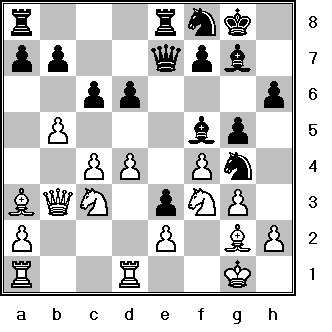
It would not be difficult for black to stop whites counterplay on the queenside by retreating the queen to c7 or d7, but then blacks offensive would also be delayed. Yusopov correctly assesses the force of his own attack and decided not to hesitate.
The key feature of the current position is blacks spearhead at e3. It imposes a powerful cramping feature to whites kingside and disturbs the communication of whites pieces.
Black has amassed a strong force aimed at the white kingside while White is behind on q-side counterplay. Sensing his difficulties Ivanchuk decides to open some lines on the queenside.
18. bxc6 bxc6
19. Ne5
The d6 pawn is pinned. There is hardly any other reasonable move for white. After 19. fxg5, hxg5 white would like to double on the b file but b1 is controlled by the f5 bishop. 20. d5 is met by 20...c5, closing the diagnol.
19...gxf4!
Further eroding whites kingside, in return for the c and d pawns. White gets some squares for his pieces for possible defense but will he be able to stop the black avalanche on his king?
20. Nxc6 Qg5
21. Bxd6 Ng6!
Yuspov piles up the pressure on the remnant of whites protective pawn cover and threatens a crushing sacrifice on h2!
22. Nd5!
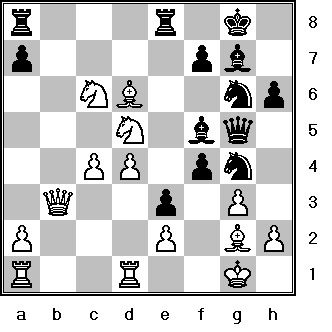
A fascinating position. The white pieces totally dominate the center, whereas the black pieces have been concentrated on the kingside.
22...Qh5!?
Yusopov playing under the unusual time control of 60 in 45 and 15/20 decides to head full bore into a speculative attack.
****************************************************
There was a stronger way to continue the attack:
VAR) 23...Nxh2! (Christiansen)
And now:
- 23.Kxh2? Qxg3+ 24. Kh1 Qh4+ 25. Kg1 Qf2+ 26. Kh1 Qxe2 is winning for black according to Christiansen though black is down in material.
For instance 27. Nxf4 Nxf4 28. Bxf4 Bc2! winning back material with interest. or 27. Nce7+, Nxe7 28. Nxe7+ Rxe7 29. Bxe7 Qh5+ 30. Kg1 Re8 and white is soon engulfed by ...f3
and
- 23. Nxf4 Qxg3 24. Nxg6 Qxg6! with the point of 25. Bxh2 Be4 wins for black.
or
- 23.gxf4 Qg3 24. Nce7+ Rxe7 (24...Nxe7 25. Qe3 is unclear) 25. Nxe7+ Nxe7 26. Qb7 Re8 and wins
- 23. Bxf4! Qh5 24. Qb7 (24. Nxe3? then ...Be4 topples the white regime.) 24...Ng4 25. Nce7+ Nxe7 26. Nxe7+ Rxe7 27. Qxe7 (27. Qxa8+, Bf8 threatens 28...Qh2+ followed by ...Be4) 27...Bf6 28. Qb7 Forced. 28...Re8 (threatening 29...Qh2+ 30. Kf1 Be4) 29. Kf1 (29. Qf3 loses outright to 29...Be4!) 29...Nf2! and despite his material advantage white is hard pressed to defend himself: eg. 30. Rdb1 Be4! 31. Qd7 Rd8! 32. Rb8 Rxb8 33. Bxb8 Qh2! is crushing. or 30. Qd5 Re4! 31. Rac1! (31. Bxe4 nxe4 32. Kg1 Nc3 is decisive) 31...Rxf4!! 32. gxf4 Qh4! 33. Kg1 (33. Qxf5 Nh3 wins) 33...Be4! 34. Bxe4+ Nh3+ wins.
Analysis by GM Christiansen
*********************************************************
23. h4 Nxh4!?
This piece sac is not sound though it does offer an extremely complex attack on the white king which offers practical chances.
At this point Short, Karpov, Korchnoi, and Gurevich had gathered in the press center and were all saying that Artur's sacrifice was incorrect.
Safer was 23...fxg3 24. Bxg3 Nxh4 25. Nf4 Qg5 26. Nh3 = Yusopov
24. gxh4 Qxh4
25. Nde7+?!
It was clearly more logical to give check with the knight on c6, keeping the d5 knight centralized where it attacks the pawns on f4 and e3. After 25. Nce7+! Kh8 26. Nxf5 Qh2+ 27. Kf1 black can try the spectacular line clearing sacrifice 27...Be5! this covers the pawn on f4 and clears the g-file for a rook while blocking the d6 bishops control of h2. With a knight on c6 this move would not have been possible. It is most likely this is the line Ivanchuk was worried about when he played the text.
Unfortunately this beautiful idea is refuted by 28. dxe5 Rg8 (threatening the amazing 29...Qh1+!! 30. Bxh1 Nh2+ followed by mate.) 29. Ndxe3 fxe3 30. e6! and blacks attack collapses.--GM Christiansen. This was obviously missed by Ivanchuk at the board. It wasnt easy to find this defense even after analysis (discovered by Yasser Seirawan I believe).
25...Kh8
26. Nxf5 Qh2+
27. Kf1
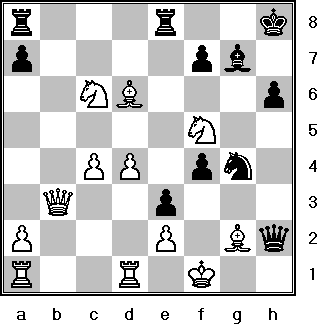
How can black strengthen his offensive? The only chance is to attack with his rook down the g-file but the routine 27...Rg8 would be refuted by 28. Nxe3!, Bxd4! (28...Nxe3 29. Qxe3) 29. Rxd4, Nxe3+ 30. Ke1, Rxg2 31. Be5+ Kg8 32. Qd3
27...Re6!
While giving the other rook a path to g8 this rook is now headed to g6.
This is not the only attacking idea in this position! Also worthy of consideration was 27...Bf6!? trying to worm its way to f2 by Bf6-h4-f2 eg 28. Rd3, Bh4! 29. Rxe3 Bf2 30. Rxe8+, Rxe8 31. e4, Qg1+ 32. Ke2, Qxg2 and black is much better as white will have to return his extra piece on f5 and face a continuing black initiative. --GM Christiansen
28. Qb7
The resource 28. Nce7! which protects the g8 and g6 squares was another try, but even this loses to 28...Rg8!! as 29. Nxg8, Rg6 30. Qxe3 (Forced), ...Nxe3 31. Nxe3, Rxd6 32. Ng4, Qg3 33. N8xh6, Bxh6 34. Ne5, f3! 35. exf3, Be3 36. Ng4, Bxd4 37. Rab1, f5 and wins. or 29. Qb2, Be5!! 30. Bxe5+ Nxe5 31. Nxg8 Rg6 32. Qb7, f3! and white is soon mated.
28...Rg6!!!
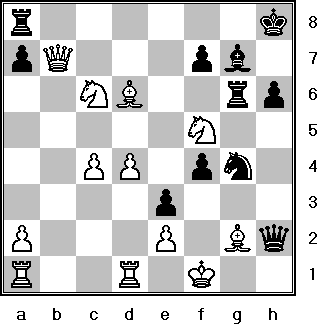
One of the most fantastic shots in chess history! Black is already down two pieces and now ofers a Rook to set up a mating combination involving a Queen sacrifice!!
29. Qxa8+ Kh7
30. Qg8+!
The only possibilty to prolong resistance. White must surrender his own Queen to stop the threatened 30...Qh1+!! when 31. Bxh1, Nh2+ 32. Ke1, Rg1 is mate) No help is 30. Nxe3 which loses to 30...Nxe3+ 31. Ke1, Rxg2 32. Kd2, Rxe2+ 33. Kc3, Rc2+ 34. Kb4, Rxc4+ 35. Kb5, Qe2! and black wins easily.
30...Kxg8
31. Nce7+, Kh7
32. Nxg6! fxg6
33. Nxg7
What should black play? Even after the capture of the g7 knight white remains ahead in material. The decisive factor in assessing the position is the desperate position of the white king.
33...Nf2!
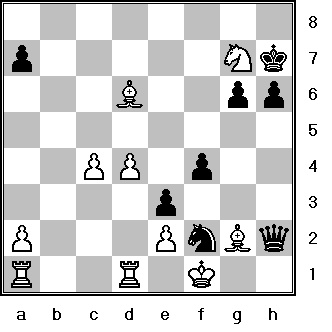
Threatening the terrifying 34...Nh3!! white must shed more material to avert mate.
34. Bxf4, Qxf4
35. Ne6
Also hopeless is 35. 35. Rdb1, Nh3+ 36. Ke1, Qh4+ 37. Kd1, Qxd4+ 38. Kc2, Qxc4+ 39. Kb2, Qxe2+.
35...Qh2
36. Rbd1, Nh3!
37. Rb7+
More stubborn was 37. Ke1, Qxg2 38. Kd1
37...Kh8
38. Rb8+, Qxb8
39. Bxh3, Qg3
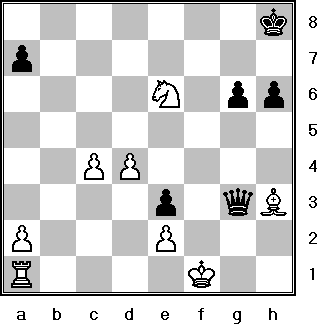
White Resigned.
0-1
GM John Nunn writing in British Chess magazine compared this game it to the masterpiece of the 19th century the "Immortal Game".
GM Yasser Sierawan titled his annotations in his chess magazine Inside Chess, "A Close Look at the Great Game."
GM Larry Christiansen called it "Yusopov's Magnum Opus" and added, "this is truly one of the most imaginative and beautiful games of the century."
Tactical Themes: Demolition, Line clearance, Deflection, Decoy, Enticement
Mating Themes: Back Rank mate, Queen and Knight Mate, Queen and Pawn Mate
I consider this to be the 7th greatest attacking game of all time.
- 23.Kxh2? Qxg3+ 24. Kh1 Qh4+ 25. Kg1 Qf2+ 26. Kh1 Qxe2 is winning for black according to Christiansen though black is down in material.
For instance 27. Nxf4 Nxf4 28. Bxf4 Bc2! winning back material with interest. or 27. Nce7+, Nxe7 28. Nxe7+ Rxe7 29. Bxe7 Qh5+ 30. Kg1 Re8 and white is soon engulfed by ...f3